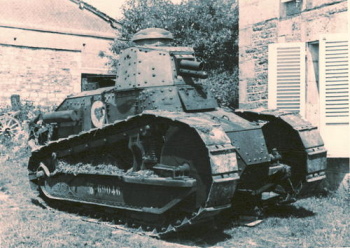Post by Diarist on Apr 18, 2015 2:23:40 GMT 1
The French Renault FT-17 of 1917 broke new ground in the field of tanks, featuring a lightweight design with armament concentrated in a traversing turret.
The Renault FT-17 series of light tank was an evolutionary design in the field of combat tanks that would go on to influence tanks for years to come. The FT-17 was designed from the outset to be of a lightweight classification which offered better mobility and road speed than its lumbering medium and heavy tank counterparts. The FT-17 brought into play two crucial design elements that are still utilized in tank design today - fully-rotating turret concentrating main armament (turrets appeared in both cast and welded forms) and an engine mounted to the rear of the hull.
The FT-17 came about, in part, through the persistence of French Army Colonel Jean-Baptiste Estienne. The idea of fielding light-class tanks in the Great War was something of a "nonsense" theory with French authorities, the accepted doctrine being on use of the large and lumbering "landships" developed by the British as heavy tanks - roaming fortresses outfitted with cannon and machine gun. Regardless, the resulting Renault light tank design, the FT-17 of 1917, produced a two-man system mounting a then-potent 37mm cannon or one or two anti-infantry 7.62mm machine guns for self-defence. The FT-17, on the surface, was as much a unique military tank design as it was in reflecting the appearance of a child's life-size riding toy due to its compact form and utilitarian appearance.
Nevertheless, the FT-17 proved crucial to French offensives in the latter years of the war and this importance spread to the American Expeditionary Force who were handed both French and British tanks as their participation increased into 1918. The Americans even adopted the FT-17 as the M1917 6-Ton and outfitted it with American-minded systems for ease of logistics. The FT-17 series was fielded from the spring of 1917 onwards though the type would not see direct operational combat until the offensives of 1918.
The FT-17 proved a highly capable armoured tracked combat system, so much so that it continued in an operational level into the post-war years. Beyond the French and American adoption, the FT-17 was also inducted into the inventories of the Italians and Russians and these went on to inspire localized forms to be developed - thusly influencing a long line of foreign tanks used throughout 1920 and into 1930. Other notable operators included Belgium, Czechoslovakia, Finland, Iran, Japan and Poland.
Large production orders during and following the Great War ensured the legacy of the system for years since its inception.
Source: The Military Factory - www.militaryfactory.com/armor/detail.asp?armor_id=225
The Renault FT-17 series of light tank was an evolutionary design in the field of combat tanks that would go on to influence tanks for years to come. The FT-17 was designed from the outset to be of a lightweight classification which offered better mobility and road speed than its lumbering medium and heavy tank counterparts. The FT-17 brought into play two crucial design elements that are still utilized in tank design today - fully-rotating turret concentrating main armament (turrets appeared in both cast and welded forms) and an engine mounted to the rear of the hull.
The FT-17 came about, in part, through the persistence of French Army Colonel Jean-Baptiste Estienne. The idea of fielding light-class tanks in the Great War was something of a "nonsense" theory with French authorities, the accepted doctrine being on use of the large and lumbering "landships" developed by the British as heavy tanks - roaming fortresses outfitted with cannon and machine gun. Regardless, the resulting Renault light tank design, the FT-17 of 1917, produced a two-man system mounting a then-potent 37mm cannon or one or two anti-infantry 7.62mm machine guns for self-defence. The FT-17, on the surface, was as much a unique military tank design as it was in reflecting the appearance of a child's life-size riding toy due to its compact form and utilitarian appearance.
Nevertheless, the FT-17 proved crucial to French offensives in the latter years of the war and this importance spread to the American Expeditionary Force who were handed both French and British tanks as their participation increased into 1918. The Americans even adopted the FT-17 as the M1917 6-Ton and outfitted it with American-minded systems for ease of logistics. The FT-17 series was fielded from the spring of 1917 onwards though the type would not see direct operational combat until the offensives of 1918.
The FT-17 proved a highly capable armoured tracked combat system, so much so that it continued in an operational level into the post-war years. Beyond the French and American adoption, the FT-17 was also inducted into the inventories of the Italians and Russians and these went on to inspire localized forms to be developed - thusly influencing a long line of foreign tanks used throughout 1920 and into 1930. Other notable operators included Belgium, Czechoslovakia, Finland, Iran, Japan and Poland.
Large production orders during and following the Great War ensured the legacy of the system for years since its inception.
Source: The Military Factory - www.militaryfactory.com/armor/detail.asp?armor_id=225

